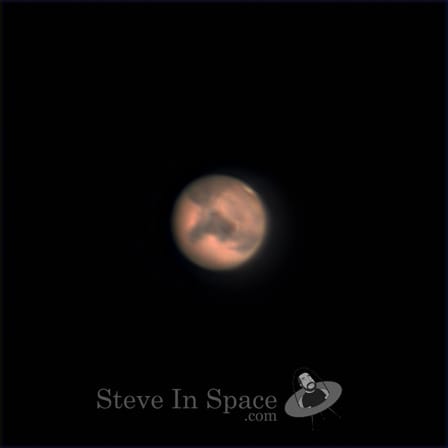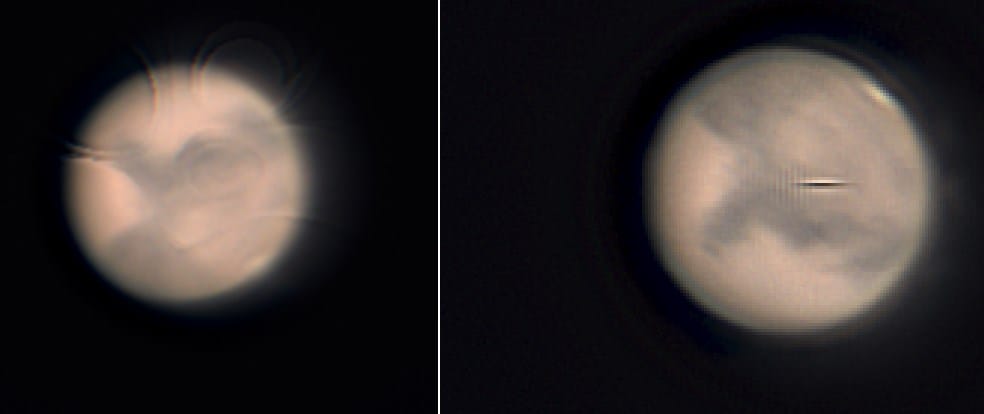Mars – 10.8.2020

Bright, but clear skies still get in the way
If you had a heartbeat this week and consumed any form of news you probably heard about Mars being the brightest it will be in our sky for another 15 years or so. Technically that pinnacle was reached on October 6th, but due to sky conditions I was unable to do any imaging until October 8th. It's so bright at a magnitude of -2.6 that the only things brighter are Venus (-4.6) and our Sun (-26.7). It's even brigher than Jupiter (-2.3) and the brightest stars in our sky, Sirius (-1.4) and Vega (0.0).
While the skies were free of clouds and the humidity wasn't horrible, the seeing (generally, the turbulence in the upper atmosphere) was not great. You really need all three things to align to better than average conditions to get a nice sharp image of a planet, even for such a bright target. The brightness helps because it means the individual exposures can be very short, which means the distortion of the turbulence is at least frozen in each frame. Still, this was a fun little session for a few different reasons.
Above is the fruit of my efforts and by far my clearest shot of Mars to date.
More is more
For the uninitatied, planetary imaging requires different techniques than deep sky and wide field. Eventhough the planets are significantly closer to Earth than any deep sky nebula or other galaxy etc, planets are angularly far smaller targets in our sky. This means you have to use higher magnification and the entirety of the image is landing on a very small area of your sensor, ie on fewer pixels. For the same reason, small distortions from turbulence and humidity etc bigger impacts.
Short of relocating to better sky conditions, we can overcome the issue of this heightened sensitivity to minute distortions with the pure brute force of volume. For a standard dim deep sky target you might take 100 frames exposed for three to five minutes each and throw out the worst 20% or so of them in post processing. But, for planetary targets we take a video of several thousand frames and you may throw out 90% of them.
For this Mars shoot, I took 14522 frames over 2 minutes. Being a little stuck in my deep sky mindset, I tried to only discard the worst 50% eventhough I knew the seeing was not great and, go figure, including too much of the poor data resulted in poor results that exhibited unsightly artifacts during post processing.

ASIAIR v1.5 - What once wasn't, is
ZWO recently released Beta firmware v1.5 for their ASIAIR pro device. This was the first time I was able to try out the new firmware, which delivered two of the most highly anticipated features since perhaps the device's initial release: auto focus and video mode.
The auto focus feature is pretty straight forward and intuitive...have the ZWO electronic focuser installed? Get it reasonably close manually then press a button and watch it chart and automatically test various focus points until it calculates the actual best focus position. In addition, it can automatically adjust the focus as the temperature changes during your automated longer running sessions for deep sky imaging. Pretty slick, and worked quite well with very little effort.
The video mode feature is what enabled planetary imaging, which is hopefully clear after reading the first part of this blog. It was easy to switch into video mode, but did take me a minute to figure out how to configure the video mode settings. Once I found it, it made sense in hindsight, but might have been nice if the firmware "out of the box" had those settings expanded into view, instead of minimized behind a << icon, which to my recollection is the first time they used that interface method. That nit aside, it was smooth sailing from then on.
A good time was had by all (me)
This was the first time I was shooting in f/10 without my focal reducer in literally 2 years. Without support for video mode on the ASIAIR, the thought of reconfiguring everything on the telescope and hauling out the old laptop setup and octopus of wires again really lacked appeal. The process of using video mode through the ASIAIR was enjoyable and has me excited to hit some planets up in the future. The nice thing about planets as opposed to deep sky targets is that they change much more frequently. Besides the rotation of the planets showing different sides to us over the months and their size in our sky changing as they get closer and further away, you've also got visible environmental factors like the dust clouds on Mars, the constant storms on Jupiter, and the phases of Venus.
Welcome back to my target list, little dots; it's not just about the far away deep sky gas clouds anymore.
